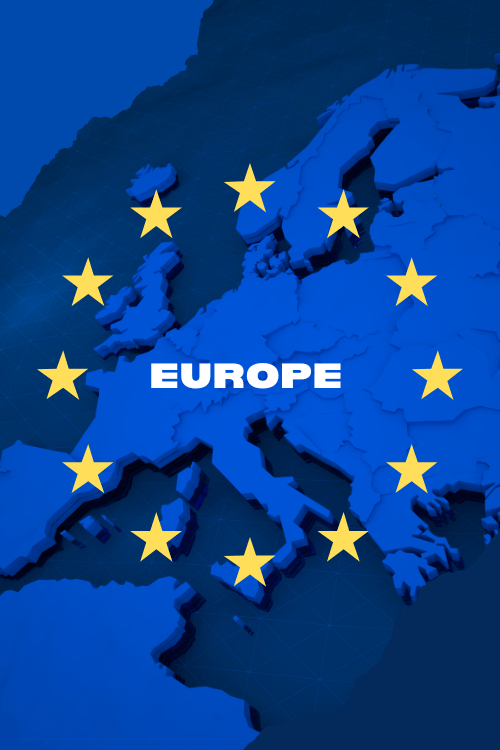eSIM Europe
How Do I Set Up eSIM For Europe?
Steps to Activate Your eSIM Plan
To activate your eSIM plan for travel in Europe, follow these general steps:
- Purchase an eSIM plan: Research and purchase an eSIM plan from a reputable provider that offers coverage in the European countries you plan to visit. Many providers offer various data options to suit your needs.
- Receive the activation details: After purchasing the plan, you will receive an email or notification with the activation details, typically a QR code or an activation code.
- Enable eSIM on your device: Navigate to the cellular or mobile data settings on your device and look for the option to add or activate an eSIM plan.
- Scan the QR code or enter the activation code: Follow the on-screen instructions to scan the QR code or manually enter the activation code provided by your eSIM provider.
- Complete the activation process: Your device will initiate the activation process, which may take a few minutes to complete. Once activated, you can start using your eSIM plan for data, voice, and text services in Europe.
Using a QR Code to Activate Your eSIM
Many eSIM providers utilize QR codes for a seamless activation process. To activate your eSIM using a QR code, follow these steps:
- Open the camera app on your device and point it at the QR code provided by your eSIM provider.
- Your device should automatically recognize the QR code and prompt you to initiate the eSIM activation process.
- Follow the on-screen instructions to complete the activation.
Common Issues and Solutions During Activation
While activating an eSIM is generally straightforward, you may encounter some issues. Here are a few common problems and their solutions:
- Connectivity issues: Ensure that your device is connected to a stable Wi-Fi or cellular network during the activation process. Poor connectivity can cause activation failures.
- Compatibility issues: Double-check that your device is eSIM-compatible and supports the frequency bands used by the eSIM provider in Europe.
- Expired or invalid activation codes: If you receive an error message indicating an invalid or expired activation code, contact your eSIM provider for assistance.
- Roaming settings: If you’re having trouble with data connectivity after activating your eSIM, ensure that data roaming is enabled on your device.
If you encounter any persistent issues during the activation process, reach out to your eSIM provider’s customer support for further assistance.
What are the Best eSIM Plans for Europe?
Below are some prepaid esim plans for Europe from esim4.com.
| Product | Current Price (USD) | Data | Validity |
|---|---|---|---|
| eSIM Europe – 1 GB | $4.97 | 1 GB | 7 Days |
| eSIM Europe – 3 GB | $12.97 | 3 GB | 30 Days |
| eSIM Europe – 5 GB | $19.97 | 5 GB | 30 Days |
| eSIM Europe – 10 GB | $36.97 | 10 GB | 30 Days |
| eSIM Europe – 50 GB | $99.97 | 50 GB | 30 Days |
| eSIM Europe – 50 GB | $140.00 | 50 GB | 90 Days |
| eSIM Europe – 100 GB | $259.00 | 100 GB | 180 Days |
How to Stay Connected While Traveling in Europe with an eSIM?
Using Mobile Data on Your eSIM
Once you’ve activated your eSIM plan, you can access mobile data services in Europe just like you would with a physical SIM card. Here are a few tips for using mobile data on your eSIM:
- Enable data roaming: Ensure that data roaming is enabled on your device to access the local cellular network in the European countries you visit.
- Monitor data usage: Keep an eye on your data usage, especially if you’re on a limited data plan. Most devices and carrier apps provide tools to track your data consumption.
- Connect to Wi-Fi when possible: Whenever available, connect to secure Wi-Fi networks to reduce your mobile data usage and save on your eSIM plan’s data allowance.
- Consider unlimited data plans: If you anticipate heavy data usage or plan to stream content frequently, an unlimited data eSIM plan may be a more cost-effective option.
Managing Your eSIM for Calls and Texts
In addition to mobile data, your eSIM plan may include voice and text services. Here’s how to manage these features:
- Configure your default line: If your device supports dual SIM functionality, you can set your eSIM as the default line for voice calls and texts.
- Use VoIP apps: Alternatively, you can use VoIP apps like FaceTime, WhatsApp, or Skype for voice and video calls over your mobile data or Wi-Fi connection.
- Check for call and text rates: Review the rates for voice calls and text messages included in your eSIM plan, as these may vary depending on the provider and the countries you’re visiting.
Tips to Avoid Roaming Fees
While eSIMs are designed to provide affordable connectivity while traveling, it’s still important to be mindful of potential roaming fees and charges. Here are some tips to help you avoid unexpected costs:
- Check your eSIM plan’s coverage area: Ensure that your eSIM plan covers all the countries you plan to visit in Europe to avoid potential roaming charges outside the covered areas.
- Disable data roaming when not in use: If you’re not using your mobile data, disable data roaming to prevent accidental data usage and charges.
- Use Wi-Fi calling and messaging: Many modern smartphones support Wi-Fi calling and messaging, allowing you to make calls and send texts over a Wi-Fi connection without using your cellular plan.
- Monitor usage and set limits: Most carrier apps and device settings allow you to set data usage limits or receive alerts when you’re approaching your plan’s data allowance.
By following these tips and being mindful of your eSIM plan’s terms and conditions, you can enjoy seamless connectivity while minimizing the risk of unexpected roaming fees during your European travels.
Can I Use an eSIM with My iPhone 14 in Europe?
Compatibility of iPhone 14 with eSIMs
The iPhone 14 series, including the iPhone 14, iPhone 14 Plus, iPhone 14 Pro, and iPhone 14 Pro Max, fully supports eSIM technology. This means that you can easily activate and use an eSIM plan on your iPhone 14 while traveling in Europe, without the need for a physical SIM card.
How to Set Up eSIM on Your iPhone 14
Setting up an eSIM on your iPhone 14 is a straightforward process. Here are the general steps:
- Purchase an eSIM plan: Choose and purchase an eSIM plan from a provider that offers coverage in the European countries you’ll be visiting.
- Receive the activation details: After purchasing the plan, you’ll receive an activation code or a QR code via email or in the provider’s app.
- Go to Settings > Mobile Data: On your iPhone 14, open the Settings app and navigate to the “Mobile Data” or “Cellular” section.
- Add a new eSIM plan: Tap on the option to add a new eSIM plan, and follow the on-screen instructions.
- Scan the QR code or enter the activation code: Use your iPhone’s camera to scan the QR code or manually enter the activation code provided by your eSIM provider.
- Complete the activation process: Your iPhone 14 will initiate the activation process, which may take a few minutes to complete.
- Enable data roaming: Once activated, ensure that data roaming is enabled on your iPhone 14 to access the local cellular network in the European countries you visit.
With an eSIM plan activated on your iPhone 14, you can stay connected to mobile data, make calls, and send texts while traveling in Europe, without the need for a physical SIM card.
What Should I Know About Data Roaming with eSIM in Europe?
Understanding Data Usage and Roaming Fees
When using an eSIM plan in Europe, it’s important to understand data usage and roaming fees to avoid unexpected charges. Here are a few key points to keep in mind:
- Data Allowance: Most eSIM plans come with a specific data allowance, either limited or unlimited. Be mindful of your data consumption, especially if you’re on a limited data plan.
- Roaming Fees: Depending on your eSIM provider and the countries you visit, roaming fees may apply when using data or making calls outside of the covered area or region.
- Fair Usage Policies: Some eSIM providers may have fair usage policies that limit or throttle data speeds after a certain threshold, even on unlimited data plans.
- Automatic Top-Ups: Some eSIM plans may automatically top up your data allowance when it runs out, which can result in additional charges. Be sure to understand your plan’s terms and conditions regarding automatic top-ups.
How to Avoid Unexpected Charges
To avoid unexpected charges while using your eSIM in Europe, follow these best practices:
- Monitor Your Data Usage: Regularly check your data usage and remaining allowance through your device’s settings or the provider’s app.
- Connect to Wi-Fi When Possible: Whenever possible, connect to secure Wi-Fi networks to reduce your mobile data usage and avoid potential roaming fees.
- Review Roaming Policies and Rates: Before traveling to a new country, review your eSIM provider’s roaming policies and rates for that specific location.
- Disable Automatic Top-Ups: If your eSIM plan offers automatic top-ups, consider disabling this feature to prevent unintended charges if you exceed your data allowance.
- Set Data Usage Limits: Many devices and carrier apps allow you to set data usage limits or receive alerts when you’re approaching your plan’s data allowance.
By being proactive and following these best practices, you can enjoy seamless connectivity while traveling in Europe with an eSIM, without the worry of unexpected charges or excessive roaming fees.
Best Practices for Using eSIM Data Plans
To make the most of your eSIM data plan while traveling in Europe, consider the following best practices:
- Download Maps and Content in Advance: Before leaving for your trip, download offline maps, translation apps, and any other content you might need to reduce data usage while on the go.
- Adjust App Settings: Configure your apps to minimize data usage by disabling automatic updates, limiting background data usage, and enabling data-saving modes where available.
- Use Messaging Apps Wisely: Instead of sending large media files or making voice calls over cellular data, consider using messaging apps like WhatsApp or Signal for text-based communication and voice calls over Wi-Fi.
- Stream Responsibly: If you plan to stream media content, do so over Wi-Fi whenever possible, or consider downloading content in advance to avoid excessive data usage.
- Stay Informed About Network Updates: Keep an eye out for any network updates or changes from your eSIM provider that may affect your data usage or roaming policies.
By following these best practices and being mindful of your data usage, you can make the most of your eSIM data plan and enjoy a seamless connectivity experience during your travels in Europe.







